The Prediction and Correction Method of Aircraft Static Aeroelastic Effects: A Review of Recent Progress
Abstract
:1. Introduction
2. Literature Review
2.1. Challenges and Progress in Aeroelasticity
2.2. Static Aeroelastic Wind Tunnel Test
2.2.1. Determination of Similarity Conditions
2.2.2. Static Aeroelastic Scaling Modeling Technology
2.2.3. High-Speed Static Aeroelastic Wind Tunnel and Test Technology
2.3. Static Aeroelastic Numerical Simulation
2.4. Static Aeroelastic Correction Method
3. Discussion
4. Conclusions
Author Contributions
Funding
Institutional Review Board Statement
Informed Consent Statement
Data Availability Statement
Conflicts of Interest
References
- Ajaj, R.M.; Parancheerivilakkathil, M.S.; Amoozgar, M.; Friswell, M.I.; Cantwell, W.J. Recent developments in the aeroelasticity of morphing aircraft. Prog. Aerosp. Sci. 2021, 120, 100682. [Google Scholar] [CrossRef]
- Tiomkin, S.; Raveh, D.E. A review of membrane-wing aeroelasticity. Prog. Aerosp. Sci. 2021, 126, 100738. [Google Scholar] [CrossRef]
- Sun, J.; Hoekstra, J.M.; Ellerbroek, J. OpenAP: An Open-Source Aircraft Performance Model for Air Transportation Studies and Simulations. Aerospace 2020, 7, 104. [Google Scholar] [CrossRef]
- Dong, G.; Wang, X.; Liu, D. Metaheuristic Approaches to Solve a Complex Aircraft Performance Optimization Problem. Appl. Sci. 2019, 9, 2979. [Google Scholar] [CrossRef] [Green Version]
- Puranik, T.; Harrison, E.; Chakraborty, I.; Mavris, D. Aircraft Performance Model Calibration and Validation for General Aviation Safety Analysis. J. Aircr. 2020, 57, 678–688. [Google Scholar] [CrossRef]
- Melis, D.J.; Silva, J.M.; Yeun, R.C. Impact of biometric and anthropometric characteristics of passengers on aircraft safety and performance. Transp. Rev. 2017, 38, 602–624. [Google Scholar] [CrossRef]
- Tian, W.; Li, Y.; Yang, Z.; Li, P.; Zhao, T. Suppression of nonlinear aeroelastic responses for a cantilevered trapezoidal plate in hypersonic airflow using an energy harvester enhanced nonlinear energy sink. Int. J. Mech. Sci. 2020, 172, 105417. [Google Scholar] [CrossRef]
- Guerrero, J.E.; Sanguineti, M.; Wittkowski, K. Variable cant angle winglets for improvement of aircraft flight performance. Meccanica 2020, 55, 1917–1947. [Google Scholar] [CrossRef]
- Hoang, N.T.B. Computational investigation of variation in wing aerodynamic load under effect of aeroelastic deformations. J. Mech. Sci. Technol. 2018, 32, 4665–4673. [Google Scholar] [CrossRef]
- Scholten, W.; Hartl, D. Uncoupled method for static aeroelastic analysis. J. Fluids Struct. 2021, 101, 103221. [Google Scholar] [CrossRef]
- Afonso, F.; Vale, J.; Oliveira, É.; Lau, F.; Suleman, A. A review on non-linear aeroelasticity of high aspect-ratio wings. Prog. Aerosp. Sci. 2017, 89, 40–57. [Google Scholar] [CrossRef]
- Pankonien, A.M.; Durscher, R.; Bhagat, N.D.; Reich, G. Multi-Material Printed Trailing Edge Control Surface for an Aeroservoelastic Wind Tunnel Model. In Proceedings of the AIAA AVIATION Forum, Atlanta, GA, USA, 25–29 June 2018. [Google Scholar] [CrossRef]
- Hoseini, H.S.; Hodges, D.H. Aeroelastic Stability Analysis of Damaged High-Aspect-Ratio Composite Wings. J. Aircr. 2019, 56, 1794–1808. [Google Scholar] [CrossRef]
- Ouyang, Y.; Zeng, K.; Kou, X.; Gu, Y.; Yang, Z. Experimental and Numerical Studies on Static Aeroelastic Behaviours of a Forward-Swept Wing Model. Shock Vib. 2021, 2021, 5535192. [Google Scholar] [CrossRef]
- Xiang, J.; Yan, Y.; Li, D. Recent advance in nonlinear aeroelastic analysis and control of the aircraft. Chin. J. Aeronaut. 2014, 27, 12–22. [Google Scholar] [CrossRef] [Green Version]
- Wang, I.; Gibbs, S.C.; Dowell, E.H. Dowell. Aeroelastic Model of Multisegmented Folding Wings: Theory and Experiment. J. Aircr. 2012, 49, 911–921. [Google Scholar] [CrossRef]
- He, S.; Guo, S.; Liu, Y.; Luo, W. Passive gust alleviation of a flying-wing aircraft by analysis and wind-tunnel test of a scaled model in dynamic similarity. Aerosp. Sci. Technol. 2021, 113, 106689. [Google Scholar] [CrossRef]
- Zhu, W. Models for wind tunnel tests based on additive manufacturing technology. Prog. Aerosp. Sci. 2019, 110, 100541. [Google Scholar] [CrossRef]
- Zhang, W.; Lv, Z.; Diwu, Q.; Zhong, H. A flutter prediction method with low cost and low risk from test data. Aerosp. Sci. Technol. 2019, 86, 542–557. [Google Scholar] [CrossRef]
- Wang, J.; Li, J.; Lei, S.; Ren, Z.; He, Y. Geometric Nonlinear Static Aeroelastic Characteristics Analysis of High-Aspect-Ratio Wing with Large Deformation. Int. J. Aeronaut. Space Sci. 2022, 23, 315–325. [Google Scholar] [CrossRef]
- Ivanco, T.G. Unique Testing Capabilities of the NASA Langley Transonic Dynamics Tunnel, an Exercise in Aeroelastic Scaling. In Proceedings of the AIAA Ground Testing Conference, San Diego, CA, USA, 24–27 June 2013. [Google Scholar] [CrossRef] [Green Version]
- Kantor, E.; Raveh, D.E.; Cavallaro, R. Nonlinear Structural, Nonlinear Aerodynamic Model for Static Aeroelastic Problems. AIAA J. 2019, 57, 2158–2170. [Google Scholar] [CrossRef]
- Lyrio, J.A.A.; Azevedo, J.L.F.; Rade, D.A.; da Silva, R.G. Computational Static Aeroelastic Analyses in Transonic Flows. In Proceedings of the Aiaa Aviation 2020 Forum, Virtual, 15–19 June 2020. [Google Scholar] [CrossRef]
- Tang, D.; Dowell, E.H. Experimental Aeroelastic Models Design and Wind Tunnel Testing for Correlation with New Theory. Aerospace 2016, 3, 12. [Google Scholar] [CrossRef] [Green Version]
- Huang, C.; Huang, J.; Song, X.; Zheng, G.; Yang, G. Three dimensional aeroelastic analyses considering free-play nonlinearity using computational fluid dynamics/computational structural dynamics coupling. J. Sound Vib. 2020, 494, 115896. [Google Scholar] [CrossRef]
- Li, D.; Da Ronch, A.; Chen, G.; Li, Y. Aeroelastic global structural optimization using an efficient CFD-based reduced order model. Aerosp. Sci. Technol. 2019, 94, 105354. [Google Scholar] [CrossRef]
- Drikakis, D.; Kwak, D.; Kiris, C.C. Computational aerodynamics: Advances and challenges. Aeronaut. J. 2016, 120, 13–36. [Google Scholar] [CrossRef] [Green Version]
- Andersen, G.; Forster, E.; Kolonay, R.; Eastep, F. Multiple Control Surface Utilization in Active Aeroelastic Wing Technology. J. Aircr. 1997, 34, 552–557. [Google Scholar] [CrossRef]
- Sundresan, M.; Joseph, D.R.; Karthick, R.; Joe, J.S.S. Review of Aeroelasticity Testing Technology. Procedia Eng. 2012, 38, 2297–2311. [Google Scholar] [CrossRef] [Green Version]
- Wan, Z.; Cesnik, C.E.S. Geometrically Nonlinear Aeroelastic Scaling for Very Flexible Aircraft. AIAA J. 2014, 52, 2251–2260. [Google Scholar] [CrossRef]
- Zhang, X.; Ju, Y.; Zhang, C. Geometry scaling technique and application to aerodynamic redesign of multi-stage transonic axial-flow compressors. Aerosp. Sci. Technol. 2021, 121, 107303. [Google Scholar] [CrossRef]
- Zhu, W.; Zuo, Z.; Li, D.; Tian, X.; Luo, M.; Shang, J.; Ding, X.; Sun, Y.; Zhang, Z.; Zhang, B. Stiffness-similar models for wind tunnel tests based on 3D printing. J. Physics: Conf. Ser. 2020, 1507, 42010. [Google Scholar] [CrossRef]
- Zhu, W.; Miao, K.; Li, D. Static aeroelastic models with integrated stiffness-contributing shell structures built by additive manufacturing. Eng. Struct. 2019, 187, 352–361. [Google Scholar] [CrossRef]
- Virgin, L. Enhancing the teaching of structural dynamics using additive manufacturing. Eng. Struct. 2017, 152, 750–757. [Google Scholar] [CrossRef]
- Molyneux, W.G. Aeroelastic Modeling; RAE Technical Note. No.353; RAE: New York, NY, USA, 1964. [Google Scholar]
- Wolowicz, C.H.; Bowman, J.S.; Gilbert, W.P. Similitude Requirements and Scaling Relationships as Applied to Model Testing; NASA Technical Paper 1435; NASA: Washington, DC, USA, 1979. [Google Scholar]
- Mawilkinson, D.G.; Blackerby, W.T. Correlation of Full-Scale Drag Predictions with Flight Measurements on the C-141A Aircraft—Phase II, Wind Tunnel Test, Analysis, and Prediction Techniques; NASA Technical Paper 2333; NASA: Washington, DC, USA, 1974. [Google Scholar]
- Heeg, J.; Spain, C.; Rivera, J. Wind Tunnel to Atmospheric Mapping for Static Aeroelastic Scaling. In Proceedings of the 5th AIAA/ASME/ASCE/AHS/ASC Structures, Structural Dynamics & Materials Conference, Palm Springs, CA, USA, 4–7 May 2009. [Google Scholar] [CrossRef] [Green Version]
- Dorothy, M.H.; Taylor, A.S. An Influence-Coefficient Approach to Static Aeroelastic Problems and a Comparison with Experiments on a Flexible Wind-Tunnel Model; RAE Technical Report, CP No.1379; RAE: New York, NY, USA, 1976. [Google Scholar]
- Abu-Zurayk, M.; Merle, A.; Ilic, C.; Keye, S.; Goertz, S.; Schulze, M.; Klimmek, T.; Kaiser, C.; Quero, D.; Häßy, J.; et al. Sensitivity-based Multifidelity Multidisciplinary Optimization of a Powered Aircraft Subject to a Comprehensive Set of Loads. In Proceedings of the Aiaa Aviation 2020 Forum, Virtual, 15–19 June 2020. [Google Scholar]
- Shrivastava, S.; Sharma, N.; Tsai, S.W.; Mohite, P. D and DD-drop layup optimization of aircraft wing panels under multi-load case design environment. Compos. Struct. 2020, 248, 112518. [Google Scholar] [CrossRef]
- Liang, L.; Wan, Z.; Yang, C. Aeroelastic optimization on composite skins of large aircraft wings. Sci. China Technol. Sci. 2012, 55, 1078–1085. [Google Scholar] [CrossRef]
- Cole, S.R.; Noll, T.E.; Perry, B. Transonic Dynamics Tunnel Aeroelastic Testing in Support of Aircraft Development. J. Aircr. 2003, 40, 820–831. [Google Scholar] [CrossRef] [Green Version]
- Blair, M.; Weiss Haa, T.A. Wind Tunnel Experiments on the Divergence of Swept Wings with Composite Structures. In Proceedings of the AlAA Aircraft Systems and Technology Conference, Dayton, OH, USA, 11–13 August 1981. [Google Scholar]
- William, J.N. Design of an Aeroelastic Composite Wing Wind Tunnel Model; AD Report, AD-A188 855; Air Force Institute of Tech: Wright-Patterson, OH, USA, 1988. [Google Scholar]
- Ostachowicz, W.M.; Kaczmarczyk, S. Vibrations of composite plates with SMA fibres in a gas stream with defects of the type of delamination. Compos. Struct. 2001, 54, 305–311. [Google Scholar] [CrossRef]
- Dunning, P.D.; Stanford, B.K.; Kim, H.A.; Jutte, C.V. Aeroelastic tailoring of a plate wing with functionally graded materials. J. Fluids Struct. 2014, 51, 292–312. [Google Scholar] [CrossRef]
- Martin, C. Control surface response of a blended wing body aeroelastic wind tunnel model. In Proceedings of the 41st Aerospace Sciences Meeting and Exhibit. J. Aircr. 2005, 42, 738–742. [Google Scholar]
- Kreshock, A.R.; Acree, C.W.; Kang, H.; Yeo, H. Development of a New Aeroelastic Tiltrotor Wind Tunnel Testbed. In Proceedings of the AIAA Scitech 2019 Forum, San Diego, CA, USA, 7–11 January 2019. [Google Scholar]
- Shanygin, A.; Dubovikov, E.; Fomin, V.; Mareskin, I.; Zichenkov, M. Designing pro-composite truss layout for load-bearing aircraft structures. Fatigue Fract. Eng. Mater. Struct. 2017, 40, 1612–1623. [Google Scholar] [CrossRef]
- French, M.; Eastep, F.E. Aeroelastic model design using parameter identification. J. Aircr. 1996, 33, 198–202. [Google Scholar] [CrossRef]
- French, M.; Kolonay, R.M. Demonstration of structural optimization applied to wind-tunnel model design. J. Aircr. 1992, 29, 966–968. [Google Scholar] [CrossRef]
- French, M. An application of structural optimization in wind tunnel model design. In Proceedings of the 31st Structures, Structural Dynamics and Materials Conference, AIAA-90-09560-CP, Long Beach, CA, USA, 2–4 April 1990. [Google Scholar]
- Chedrik, V.; Ishmuratov, F.; Zichenkov, M.; Azarov, Y. Optimization approach to design of aeroelastic dynamically-scaled models of airplane. In Proceedings of the 10th AIAA/ISSMO Multidisciplinary Analysis and Optimization Conference, Albany, NY, USA, 30 August–1 September 2004. [Google Scholar]
- Kenway, G.K.W.; Kennedy, G.J.; Martins, J.R.R.A. Scalable Parallel Approach for High-Fidelity Steady-State Aeroelastic Analysis and Adjoint Derivative Computations. AIAA J. 2014, 52, 935–951. [Google Scholar] [CrossRef] [Green Version]
- Brian, H.M.; Stroud, W.J.; Krishnamurthy, T.; Charles, D.; Spain, V. Probabilistic design of a wind tunnel model to match the response of a full-scale airplane. In Proceedings of the 46th AIAA/ASME/ASCE/AHS/ASC Structures, Structural Dynamics & Materials Conference, Austin, TX, USA, 18–21 April 2005. [Google Scholar]
- Cole, S.; Garcia, J. Past, present, and future capabilities of the Transonic Dynamics Tunnel from an aeroelasticity perspective. In Proceedings of the AIAA Dynamics Specialists Conference, Atlanta, GA, USA, 5–6 April 2000. [Google Scholar]
- Burner, A.W.; Fleming, G.A.; Hoppe, J.C. Comparison of three optical methods for measuring model deformation. In Proceedings of the 38th Aerospace Sciences Meeting & Exhibit, Reno, NV, USA, 10–13 January 2000. [Google Scholar]
- Perry, B.; Cole, S.R.; Miller, G.D. Summary of an Active Flexible Wing program. J. Aircr. 1995, 32, 10–15. [Google Scholar] [CrossRef]
- Florance, J.; Heeg, J.; Spain, C.; Ivanco, T.; Wieseman, C.; Lively, P. Variable Stiffness Spar Wind-Tunnel Model Development and Testing. In Proceedings of the 45th AIAA/ASME/ASCE/AHS/ASC Structures, Structural Dynamics & Materials Conference, Palm Springs, CA, USA, 19–22 April 2004. [Google Scholar]
- Heeg, J.; Spain, C.V.; Florance, J.R.; Wieseman, C.D.; Ivanco, T.G.; Demoss, J.A.; Silva, W.A. Experimental Results from the Active Aeroelastic Wing Wind Tunnel Test Program. In Proceedings of the 46th AIAA/ASME/ASCE/AHS/ASC Structures, Structural Dynamics & Materials Conference, Austin, TX, USA, 18–21 April 2005. [Google Scholar]
- Dietz, G.; Mai, H.; Schröder, A.; Klein, C.; Moreaux, N.; Leconte, P. Unsteady Wing-Pylon-Nacelle Interference in Transonic Flow. J. Aircr. 2008, 45, 934–944. [Google Scholar] [CrossRef]
- Yang, Z.; Gu, X.; Liang, X.; Ling, L. Study on optimal design of composite materials by neural network and expert System. Aerosp. Mater. Technol. 2008, 4, 1–5. [Google Scholar]
- Qian, W.; Zhang, G.; Liu, Z. Design, manufacture and low speed wind tunnel test of a high aspect ration wing static aeroelastic model. J. Exper. Fluid Mech. 2013, 27, 93–97. [Google Scholar]
- Schuster, D.M.; Liu, D.D.; Huttsell, L.G. Computational Aeroelasticity: Success, Progress, Challenge. J. Aircr. 2003, 40, 843–856. [Google Scholar] [CrossRef] [Green Version]
- An, X.; Xu, M.; Chen, S. A review of nonlinear aeroelasticity with multi-field coupling. Mech. Prog. 2009, 39, 284–298. [Google Scholar]
- Huang, C.; Huang, J.; Song, X.; Zheng, G.; Nie, X. Aeroelastic Simulation Using CFD/CSD Coupling Based on Precise Integration Method. Int. J. Aeronaut. Space Sci. 2020, 21, 750–767. [Google Scholar] [CrossRef]
- Prasad, R.; Choi, S.; Patil, M. Aerodynamic shape optimization using a time spectral coupled adjoint for nonlinear aeroelastic problems. Aerosp. Sci. Technol. 2022, 126, 107495. [Google Scholar] [CrossRef]
- Theodorsen, T. General Theory of Aerodynamic Instability and the Mechanism of Flutter; NACA: Washington, DC, USA, 1936. [Google Scholar]
- Liu, Q. A review of Green function algorithms for subsonic, transonic and supersonic steady and unsteady aerodynamics of complex configurations. J. Aviat. 1996, 17, 2. [Google Scholar]
- Fang, M.; Bai, J.; Wang, J.; Fan, R. Research on Transonic Flutter Based on unstructured dynamic grids. Mach. Des. Manuf. 2007, 11, 3. [Google Scholar]
- Terrence, E.L.; Weisshaar, A. Aeroelasticity of Nonconventional Airplane Configurations-Past and Future. J. Aircr. 2003, 40, 1047–1065. [Google Scholar]
- Kamakoti, R.; Shyy, W.; Thakur, S.; Sankar, B. Time dependent RANS computation for an aeroelastic wing. In Proceedings of the 42nd AIAA Aerospace Sciences Meeting and Exhibit, Reno, NV, USA, 5–8 January 2004. [Google Scholar]
- Rizzetta, D.P.; Visbal, M.R.; Gaitonde, D.V. Direct numerical and large-eddy simulation of supersonic flows by a high-order method. In Proceedings of the Fluids 2000 Conference and Exhibit, Denver, CO, USA, 19 June 2000–22 June 2000. [Google Scholar]
- Guarini, S.E.; Moser, R.D.; Shariff, K.; Wray, A. Direct numerical simulation of a supersonic turbulent boundary layer at Mach 2.5. J. Fluid Mech. 2000, 414, 1–33. [Google Scholar] [CrossRef]
- Spalart, P.R.; Allmaras, S.R. Comments on the feasibility of les for wing and on a hyhrid rans/les approach and advance in DNS/LES. In Proceedings of the 1st AFOSR Conerfence on DNS/LES, Columbus, OH, USA, 4–8 August 1997. [Google Scholar]
- Camelli, F.; Loehner, R. Combining the Baldwin Lomax and Smagorinsky turbulence models to calculate flows with separation regions. In Proceedings of the 40th AIAA Aerospace Sciences Meeting & Exhibit, Reno, NV, USA, 14–17 January 2002. [Google Scholar]
- Mccullers, L.A. Aircraft Configuration Optimization Including Optimized Flight Profiles; Langley Research Center Recent Experiences in Multidisciplinary Analysis and Optimization, Part 1; Langley Research Center: Hampton, VA, USA, 1984. [Google Scholar]
- Banerjee, J.R.; Williams, F.W. Free vibration of composite beams—An exact method using symbolic computation. J. Aircr. 1995, 32, 636–642. [Google Scholar] [CrossRef]
- Weisshaar, T.A.; Foist, B.L. Vibration tailoring of advanced composite lifting surfaces. J. Aircr. 1985, 22, 141–147. [Google Scholar] [CrossRef]
- Lillico, M.; Butler, R. Aeroelastic optimization of composite wings using the dynamic stiffness method. Aeronaut. J. 1997, 101, 77–86. [Google Scholar]
- Librescu, L.; Thangjitham, S. Analytical studies on static aeroelastic behavior of forward-swept composite wing structures. J. Aircr. 1991, 28, 151–157. [Google Scholar] [CrossRef]
- Kapania, R.K.; Castel, F. A simple element for aeroelastic analysis of undamaged and damaged wings. AIAA J. 1990, 28, 329–337. [Google Scholar] [CrossRef]
- Lee, U. Equivalent dynamic beam-rod models of airplane wing structures. Aeronaut. J. 1995, 99, 450–457. [Google Scholar]
- Giles, G.L. Equivalent plate analysis of aircraft wing box structures with general planform geometry. J. Aircr. 1986, 23, 859–864. [Google Scholar] [CrossRef]
- Livne, E.; Sels, R.A.; Bhatia, K.G. Lessons from application of equivalent plate structural molding to an HSCT wing. J. Aircr. 1994, 31, 953–960. [Google Scholar] [CrossRef]
- Giles, G.L. Further generalization of an equivalent plate representation for aircraft structural analysis. J. Aircr. 1989, 26, 67–74. [Google Scholar] [CrossRef] [Green Version]
- Lei, R.; Bai, J.; Xu, D. Aerodynamic optimization of civil aircraft with wing-mounted engine jet based on adjoint method. Aerosp. Sci. Technol. 2019, 93, 105285. [Google Scholar] [CrossRef]
- Wang, N.; Ma, R.; Chang, X.; Zhang, L. Numerical Virtual Flight Simulation of Quasi-Cobra Maneuver of a Fighter Aircraft. J. Aircr. 2021, 58, 138–152. [Google Scholar] [CrossRef]
- Etienne, S.; Pelletier, D.; Garon, A. A Monolithic Formulation for Steady-State Fluid-Structure Interaction Problems. In Proceedings of the 34th AIAA Fluid Dynamics Conference and Exhibit, Portland, OR, USA, 28 June–1 July 2004. [Google Scholar] [CrossRef]
- Batina, J.T. Unsteady Euler algorithm with unstructured dynamic mesh for complex-airplane aeroelastic analysis. AIAA J. 2012, 29, 1991. [Google Scholar]
- Batina, J.T. Unsteady Euler algorithm with unstructured dynamic mesh for complex-aircraft aerodynamic analysis. AIAA J. 1991, 29, 327–333. [Google Scholar] [CrossRef]
- Robinson, B.A.; Batina, J.T.; Yang, H.T.Y. Aeroelastic analysis of wings using the Euler equations with a deforming mesh. J. Aircr. 1991, 28, 781–788. [Google Scholar] [CrossRef]
- Cavallo, P.A.; Hosangadi, A.; Lee, R.A.; Dash, S.M. Dynamic unstructured grid methodology with application to aero/propulsive flowfields. In Proceedings of the 15th Applied Aerodynamics Conference, Atlanta, GA, USA, 23–25 June 1997. [Google Scholar]
- Martineau, D.G.; Georgala, J.M. A mesh movement algorithm for high quality generalised meshes. In Proceedings of the 42nd AIAA Aerospace Sciences Meeting and Exhibit, Reno, NV, USA, 5–8 January 2004. [Google Scholar]
- Liu, X.; Qin, N.; Xia, H. Fast dynamic grid deformation based on Delaunay graph mapping. J. Comput. Phys. 2006, 211, 405–423. [Google Scholar] [CrossRef]
- Zheng, G. Aeroelasticity Research Based on Hybrid Grid Parallel Algorithm for Navier-Stokes Equations; Institute of Mechanics, Chinese Academy of Sciences: Beijing, China, 2010. [Google Scholar]
- Huang, W.; Ren, Y.; Russell, R.D. Moving Mesh Methods Based on Moving Mesh Partial Differential Equations. J. Comput. Phys. 1994, 113, 279–290. [Google Scholar] [CrossRef] [Green Version]
- Huang, W.; Russell, R.D. Moving Mesh Strategy Based on a Gradient Flow Equation for Two-Dimensional Problems. SIAM J. Sci. Comput. 1998, 20, 998–1015. [Google Scholar] [CrossRef] [Green Version]
- Won, A.S.F.; Tsai, H.M. Unsteady flow calculations with a multi-block moving mesh algorithm. In Proceedings of the 38th Aerospace Sciences Meeting 81 Exhibit, Reno, NV, USA, 10–13 January 2000. [Google Scholar]
- Potsdam, M.A.; Guruswamy, G.P. A parallel multiblock mesh movement scheme for complex aeroelastic applica-tions. In Proceedings of the 39th AIAA Aerospace Sciences Meeting & Exhibit, Reno, NV, USA, 8–11 January 2001. [Google Scholar]
- Gao, X.; Chen, P.; Tang, L. Deforming Mesh for Computational Aeroelasticity Using a Nonlinear Elastic Boundary Element Method. AIAA J. 2002, 40, 1512–1517. [Google Scholar] [CrossRef]
- Chen, P.; Hill, L. A three-dimensional boundary element method for CFD/CSD grid interfacing. In Proceedings of the 40th Structures, Structural Dynamics, and Materials Conference and Exhibit, St. Louis, MO, USA, 12–15 April 1999. [Google Scholar] [CrossRef]
- Chen, P.C.; Gao, X.W. A multi-block boundary element method for CFD/CSD grid interfacing. In Proceedings of the 39th Aerospace Sciences Meeting and Exhibit, Reno, NV, USA, 8–11 January 2001. [Google Scholar]
- Huang, L.; Gao, Z.; Zhang, D. Research on multi-fidelity aerodynamic optimization methods. Chin. J. Aeronaut. 2013, 26, 279–286. [Google Scholar] [CrossRef] [Green Version]
- Yang, G.; Chen, D.; Cui, K. Response Surface Technique for Static Aeroelastic Optimization on a High-Aspect-Ratio Wing. J. Aircr. 2009, 46, 1444–1450. [Google Scholar] [CrossRef]
- Zhao, W.; Kapania, R.K. Static Aeroelastic Optimization of Aircraft Wing with Multiple Surfaces. In Proceedings of the 18th AIAA/ISSMO Multidisciplinary Analysis and Optimization Conference, Denver, CO, USA, 5–9 June 2017. [Google Scholar]
- Kontogiannis, S.G.; Demange, J.; Savill, A.M.; Kipouros, T. A comparison study of two multifidelity methods for aerodynamic optimization. Aerosp. Sci. Technol. 2019, 97, 105592. [Google Scholar] [CrossRef]
- Qiu, Y.; Bai, J.; Liu, N.; Wang, C. Global aerodynamic design optimization based on data dimensionality reduction. Chin. J. Aeronaut. 2018, 31, 643–659. [Google Scholar] [CrossRef]
- Renganathan, S.A.; Maulik, R.; Ahuja, J. Enhanced data efficiency using deep neural networks and Gaussian processes for aerodynamic design optimization. Aerosp. Sci. Technol. 2021, 111, 106522. [Google Scholar] [CrossRef]
- Chen, W.; Chiu, K.; Fuge, M. Aerodynamic Design Optimization and Shape Exploration using Generative Adversarial Networks. In Proceedings of the AIAA Scitech 2019 Forum, San Diego, CA, USA, 7–11 January 2019. [Google Scholar]
- Li, J.; Zhang, M.; Martins, J.R.R.A.; Shu, C. Efficient Aerodynamic Shape Optimization with Deep-Learning-Based Geometric Filtering. AIAA J. 2020, 58, 4243–4259. [Google Scholar] [CrossRef]
- Wang, N.; Chang, X.; Zhao, Z.; Ma, R.; Zhang, L. Aerodynamic performance prediction and credibility study of the transport model CHN-T1 based on HyperFLOW solver. Acta Aerodyn. Sin. 2019, 37, 301–309. [Google Scholar]
- Dillinger, J.K.S.; Abdalla, M.M.; Meddaikar, Y.M.; Klimmek, T. Static aeroelastic stiffness optimization of a forward swept composite wing with CFD-corrected aero loads. CEAS Aeronaut. J. 2019, 10, 1015–1032. [Google Scholar] [CrossRef] [Green Version]
- He, C.; Wang, P.; Liu, Y. Sequential Data Assimilation of Turbulent Flow and Pressure Fields over Aerofoil. AIAA J. 2022, 60, 1091–1103. [Google Scholar] [CrossRef]
- Zhao, X.; Kania, R.; Kebbie-Anthony, A.B.; Azarm, S.; Balachandran, B. Dynamic Data-Driven Aeroelastic Response Prediction with Discrete Sensor Observations. In Proceedings of the 2018 AIAA Non-Deterministic Approaches Conference, Kissimmee, FL, USA, 8–12 January 2018; pp. 1–12. [Google Scholar] [CrossRef]
- Barakos, G.; Drikakis, D.; Lefebre, W. Improvement to Numerical Predictions of Aerodynamic Flows Using Experimental Data Assimilation. J. Aircr. 1999, 36, 611–614. [Google Scholar] [CrossRef]
- Zhang, Y.; Du, L.; Zhang, W.; Deng, Z. Research on data assimilation strategy of turbulent separated flow over airfoil. Appl. Math. Mech. 2022, 43, 571–586. [Google Scholar] [CrossRef]
- Liu, Y.; Zhang, W.; Xia, Z. A new data assimilation method of recovering turbulent mean flow field at high Reynolds numbers. Aerosp. Sci. Technol. 2022, 126, 107328. [Google Scholar] [CrossRef]
- Kato, H.; Yoshizawa, A.; Ueno, G.; Obayashi, S. A data assimilation methodology for reconstructing turbulent flows around aircraft. J. Comput. Phys. 2015, 283, 559–581. [Google Scholar] [CrossRef]
- Kou, J.; Zhang, W. Data-driven modeling for unsteady aerodynamics and aeroelasticity. Prog. Aerosp. Sci. 2021, 125, 100725. [Google Scholar] [CrossRef]
- Sarma, R.; Dwight, R.P. Uncertainty Reduction in Aeroelastic Systems with Time-Domain Reduced-Order Models. AIAA J. 2017, 55, 2437–2449. [Google Scholar] [CrossRef]
- Garrick, I.; Garrick, L. Aeroelasticity-Frontiers and Beyond. J. Aircr. 1976, 13, 641–657. [Google Scholar] [CrossRef]
- Thelen, A.S.; Leifsson, L.T.; Beran, P.S. Aeroelastic Flutter Prediction using Multi-fidelity Modeling of the Aerodynamic Influence Coefficients. In Proceedings of the AIAA Scitech 2019 Forum, San Diego, CA, USA, 7–11 January 2019. [Google Scholar] [CrossRef]
- Spivey, N.; Saltzman, R.; Wieseman, C.; Napolitano, K.; Smith, B. Passive Aeroelastic Tailored Wing Modal Test Using the Fixed Base Correction Method. Top. Modal Anal. Test. 2020, 8, 61–83. [Google Scholar] [CrossRef]
- Gobal, K.; Grandhi, R.V. Nonlinear Aeroelastic Analysis of High Aspect-Ratio Wings Using Immersed Boundary Technique. In Proceedings of the 53rd AIAA Aerospace Sciences Meeting, Kissimmee, FL, USA, 5–9 January 2015. [Google Scholar]
- Eldred, M.S.; Venkayya, V.B.; Anderson, W.J. New mode tracking methods in aeroelastic analysis. AIAA J. 1995, 33, 1292–1299. [Google Scholar] [CrossRef] [Green Version]
- Riley, M.E.; Grandhi, R.V.; Kolonay, R. Quantification of Modeling Uncertainty in Aeroelastic Analyses. J. Aircr. 2011, 48, 866–873. [Google Scholar] [CrossRef]
- Abel, I. Evaluation of Techniques for Predicting Static Aeroelastic Effects on Flexible Aircraft. J. Aircr. 1972, 9, 43–47. [Google Scholar] [CrossRef]
- Wu, K. A preliminary study on theoretical calculation and correction method of aeroelasticity for aircraft. Pneum. Res. Dev. 1978, 1, 11–16. [Google Scholar]
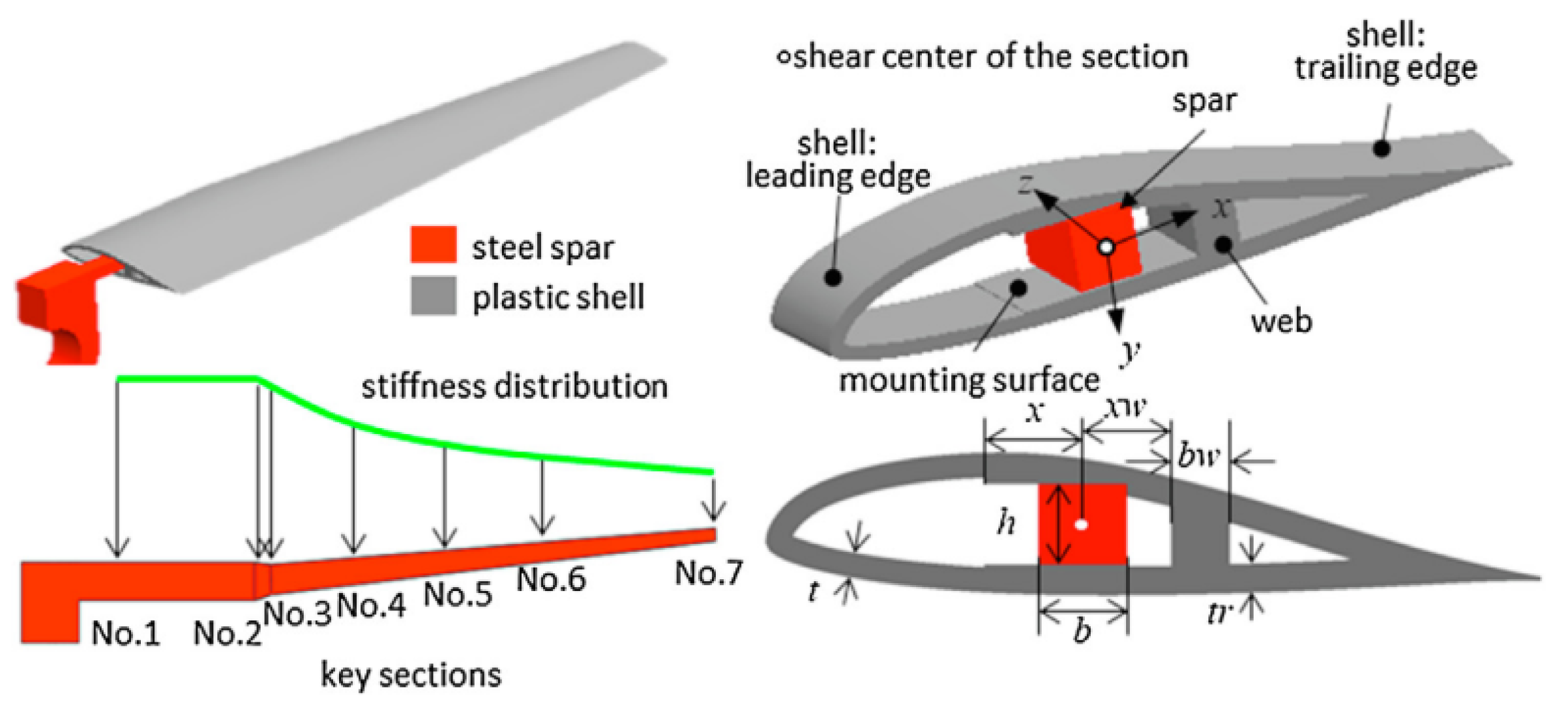
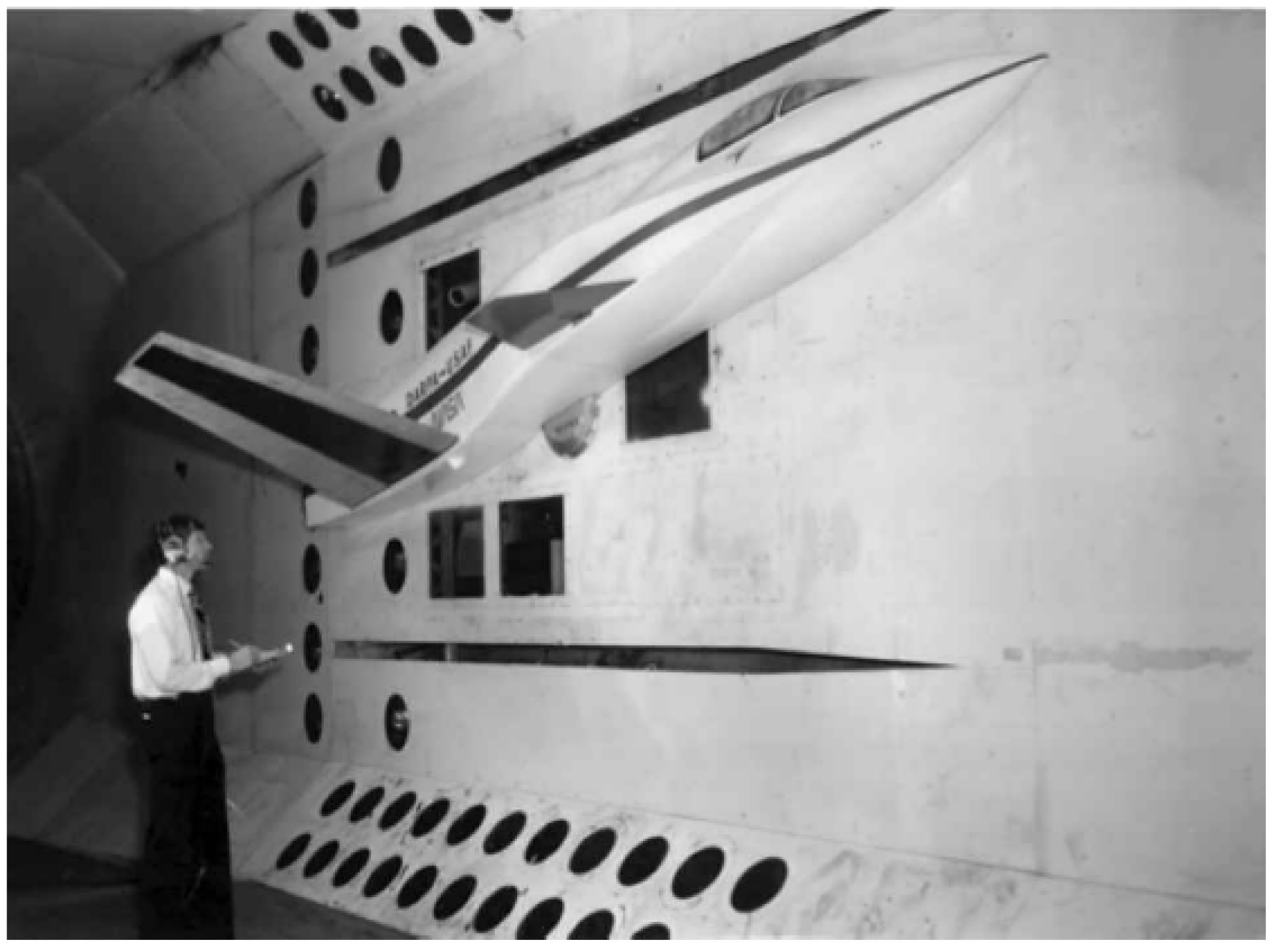
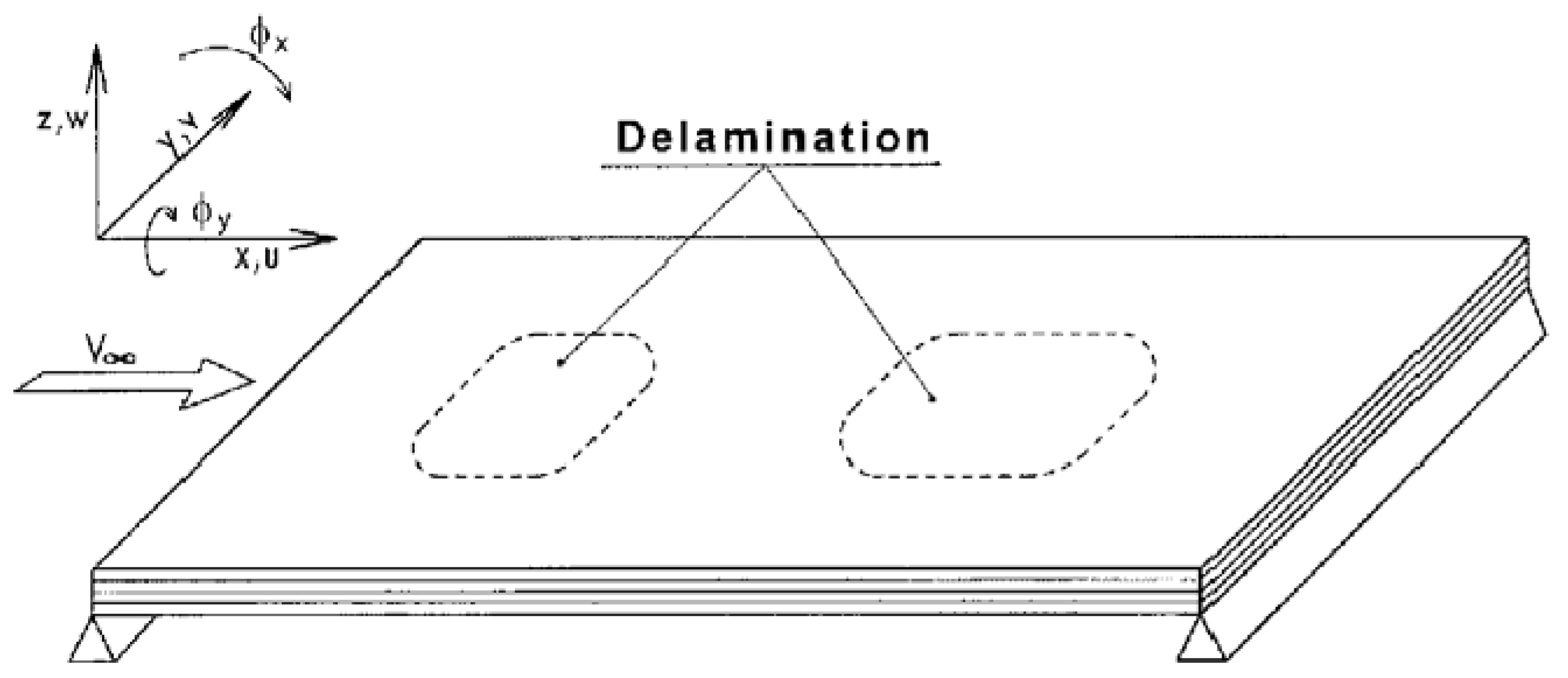
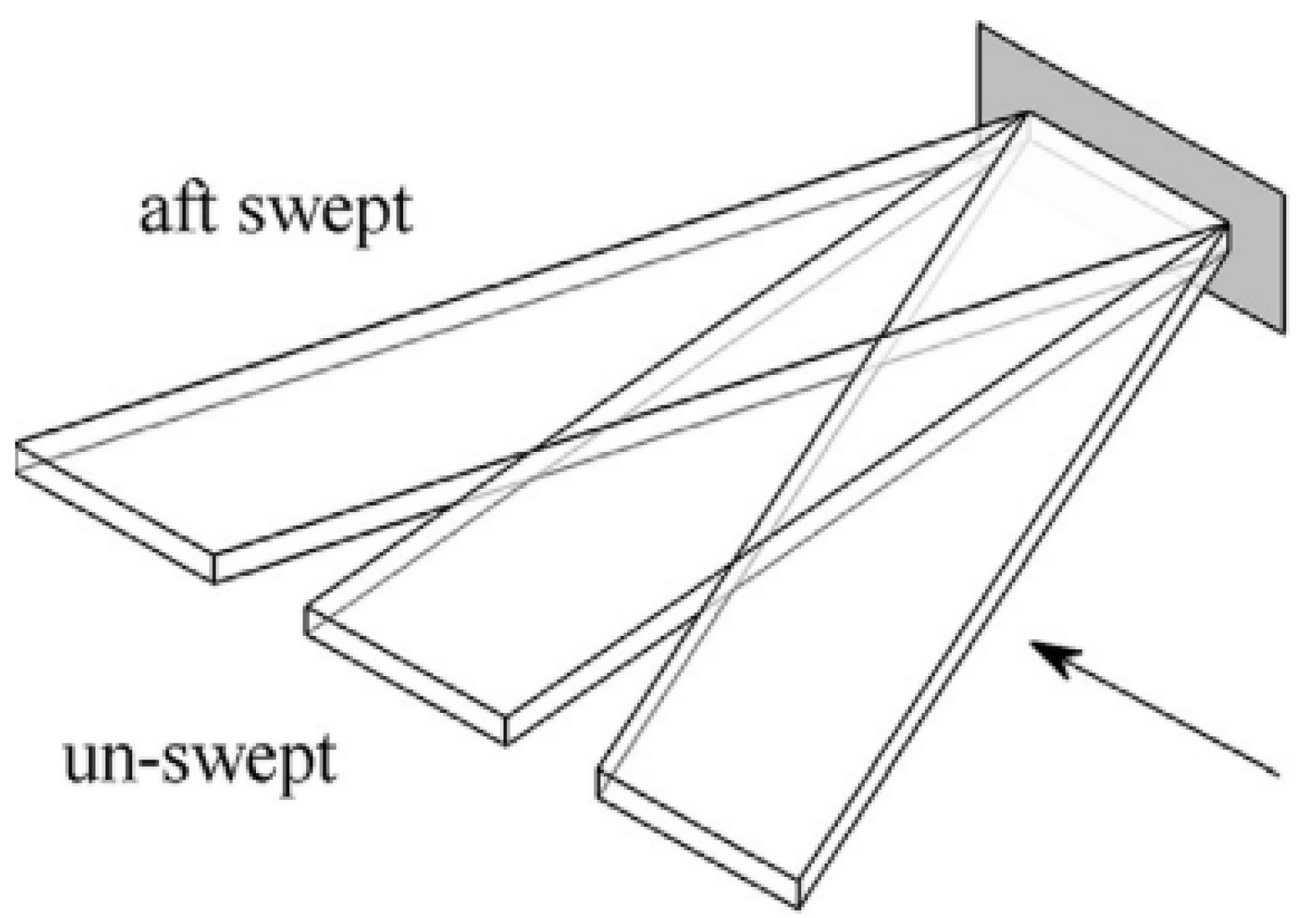
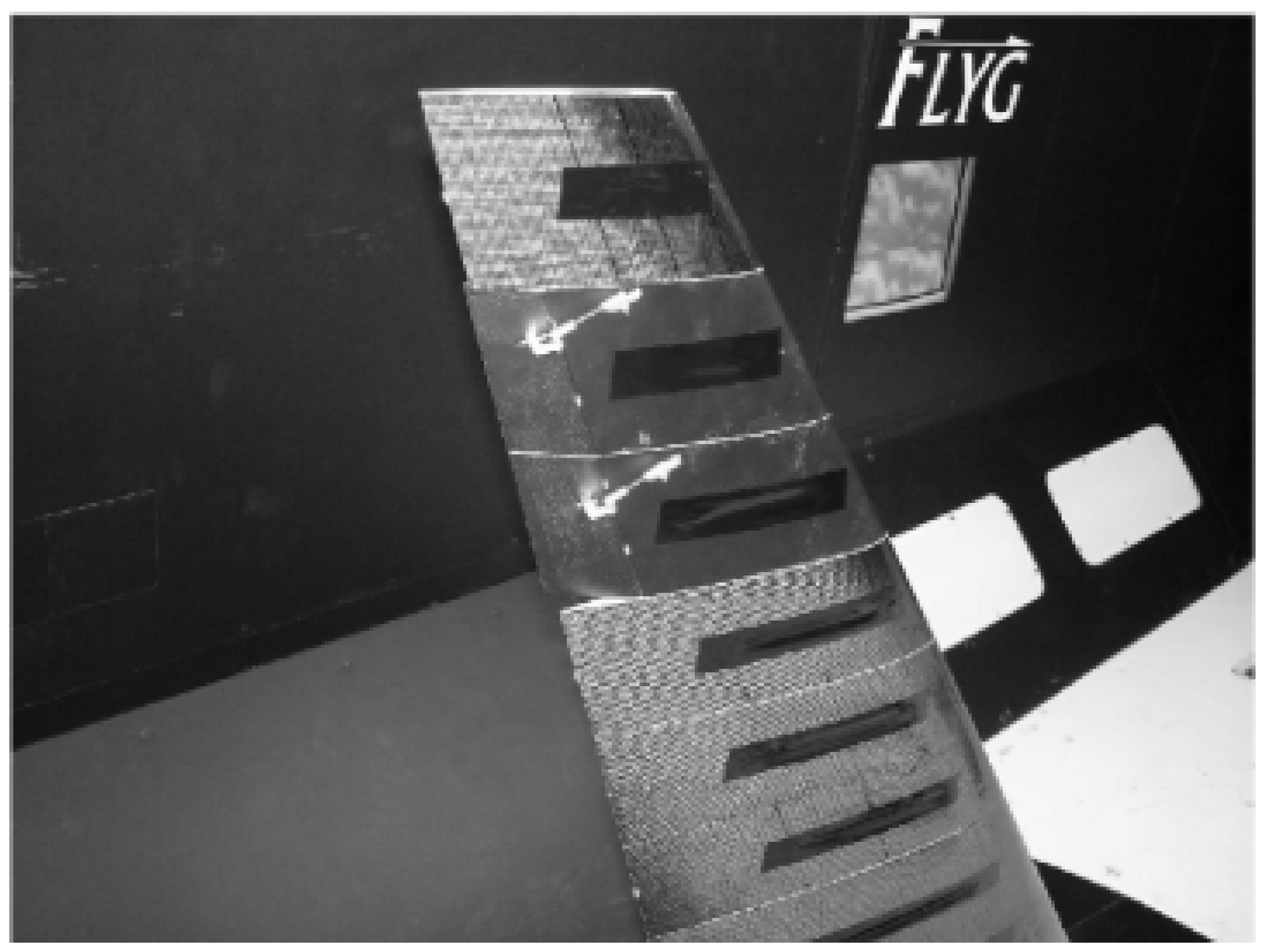
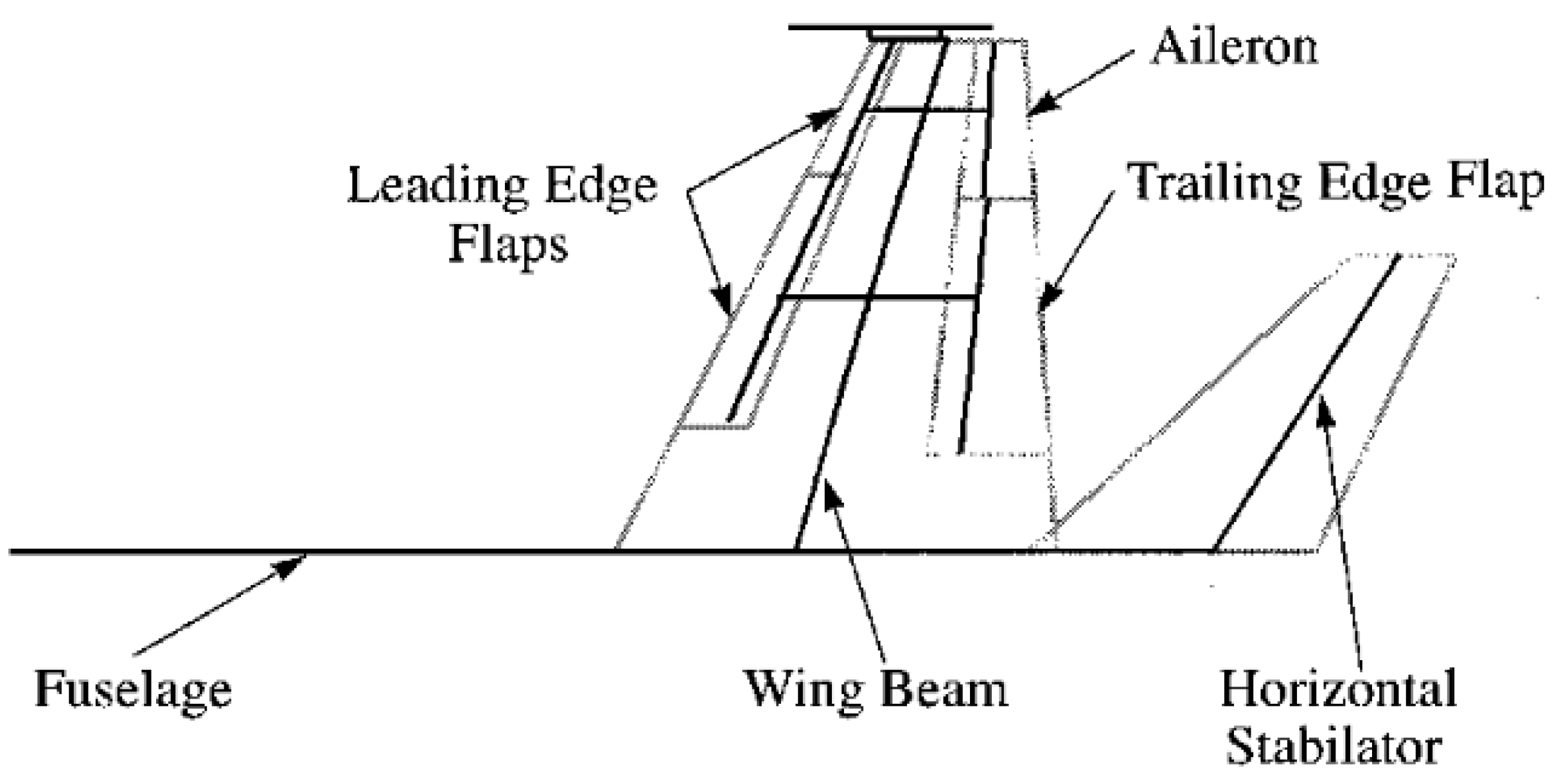

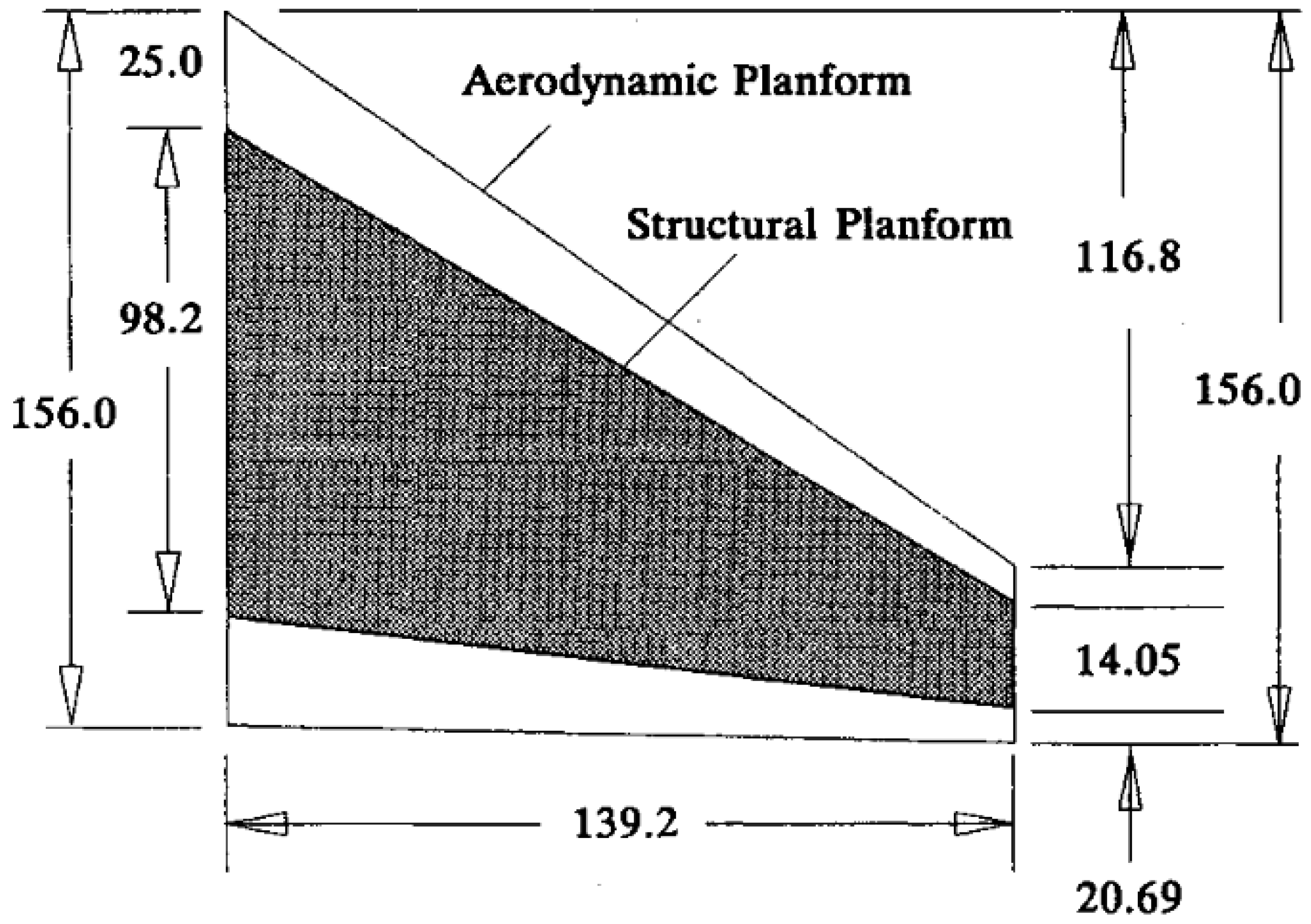

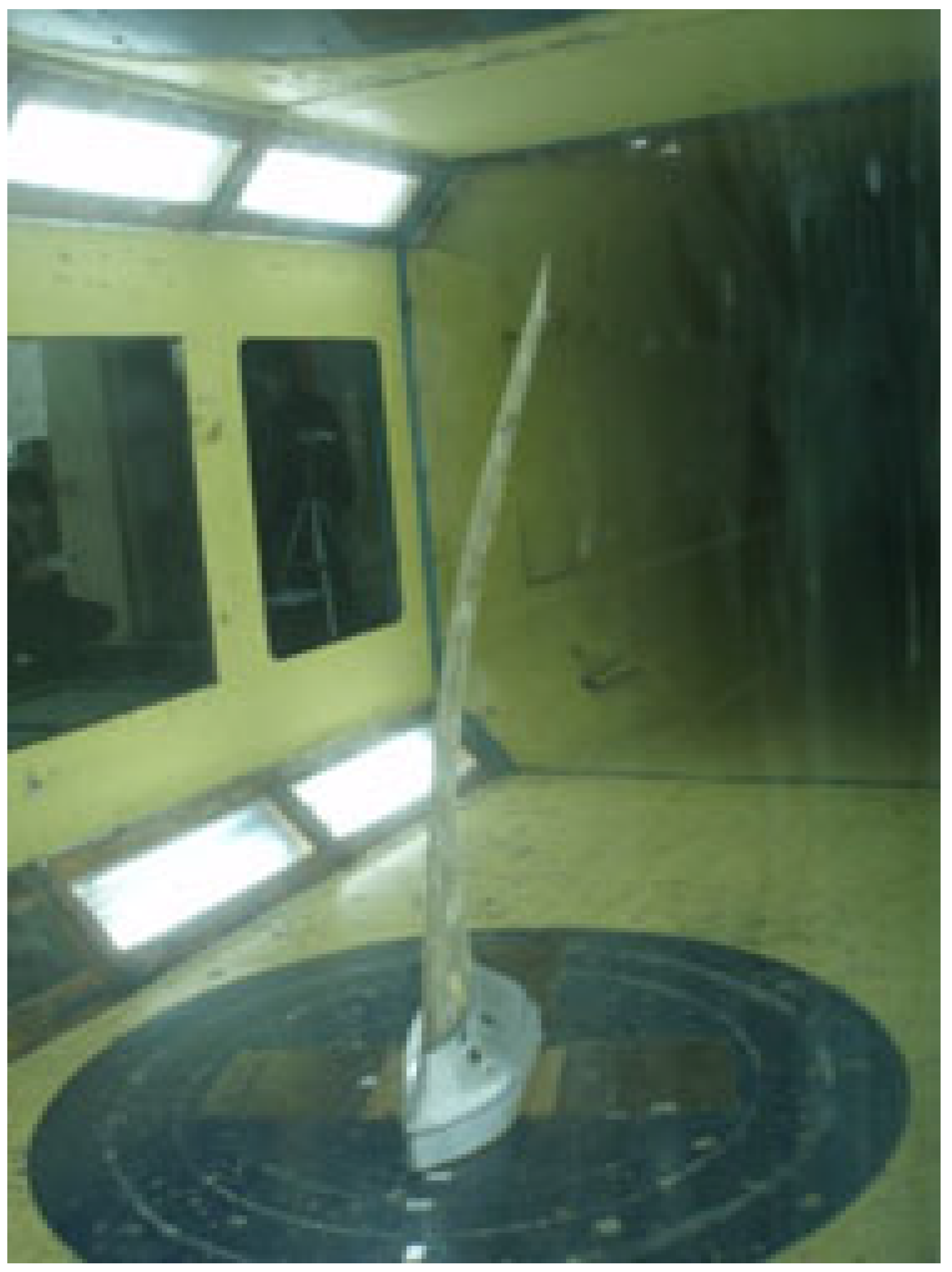


| Material | Tensile Strength (MPa) | Tensile Modulus (GPa) | Strength (MPa·cm3/g) | Stiffness (GPa·cm3/g) | Density (g/cm3) |
|---|---|---|---|---|---|
| Aluminum | 420 | 72 | 151.1 | 25.9 | 2.78 |
| Steel (structural) | 1200 | 206 | 152.9 | 26.3 | 7.85 |
| Titanium alloy | 1000 | 116.7 | 221.2 | 25.8 | 4.52 |
| Glass fiber/polyester composite material | 1245 | 48.2 | 623 | 24.1 | 2.0 |
| High-strength carbon/epoxy resin | 1471 | 137.3 | 1014 | 94.7 | 1.45 |
| High modulus carbon/epoxy resin | 1049 | 235 | 656 | 146.9 | 1.6 |
| Aramid/epoxy resin | 1373 | 78.4 | 981 | 56 | 1.4 |
Publisher’s Note: MDPI stays neutral with regard to jurisdictional claims in published maps and institutional affiliations. |
© 2022 by the authors. Licensee MDPI, Basel, Switzerland. This article is an open access article distributed under the terms and conditions of the Creative Commons Attribution (CC BY) license (https://creativecommons.org/licenses/by/4.0/).
Share and Cite
Guo, H.; Yan, Y.; Xia, H.; Yu, L.; Lv, B. The Prediction and Correction Method of Aircraft Static Aeroelastic Effects: A Review of Recent Progress. Actuators 2022, 11, 309. https://doi.org/10.3390/act11110309
Guo H, Yan Y, Xia H, Yu L, Lv B. The Prediction and Correction Method of Aircraft Static Aeroelastic Effects: A Review of Recent Progress. Actuators. 2022; 11(11):309. https://doi.org/10.3390/act11110309
Chicago/Turabian StyleGuo, Hongtao, Yu Yan, Hongya Xia, Li Yu, and Binbin Lv. 2022. "The Prediction and Correction Method of Aircraft Static Aeroelastic Effects: A Review of Recent Progress" Actuators 11, no. 11: 309. https://doi.org/10.3390/act11110309
APA StyleGuo, H., Yan, Y., Xia, H., Yu, L., & Lv, B. (2022). The Prediction and Correction Method of Aircraft Static Aeroelastic Effects: A Review of Recent Progress. Actuators, 11(11), 309. https://doi.org/10.3390/act11110309





